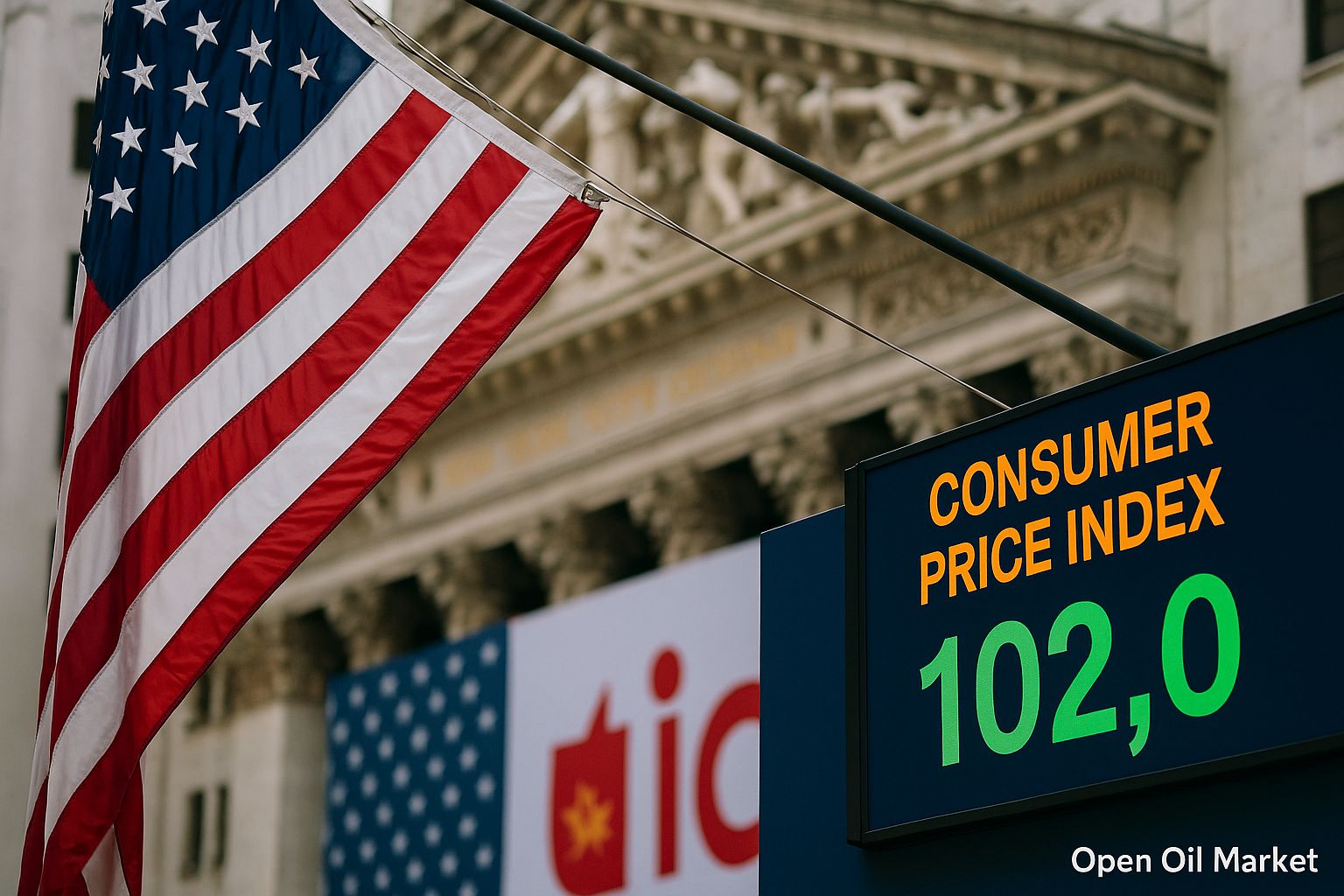
Analysis of Economic Events and Corporate Reports for Sunday, November 9, 2025. Inflation in China, Reports from Occidental Petroleum, Tyson Foods, and Barrick Gold, Expectations for U.S. Inflation Data, and Investor Guidelines for the Upcoming Week.
Sunday establishes a critical context prior to the opening of global markets. Investors from Russia and the CIS countries are closely monitoring the morning inflation data from China and assessing any weekend news that could impact commodity and currency markets. Stock exchanges in the CIS and Europe are closed this Sunday, but analysts’ attention shifts to upcoming key indicators from the U.S. and Europe—particularly the Consumer Price Index (CPI) release from the U.S. midweek—as well as a series of corporate reports that will set the tone for various sectors at the start of the new week.
Macroeconomic Calendar (Moscow Time)
- 04:30 – China: Consumer Price Index (CPI) for October.
- 04:30 – China: Producer Price Index (PPI) for October.
Asia: Inflation in China
Statistics from Beijing indicate a continuation of deflationary trends, although their intensity is easing. Year-on-year consumer prices in China remained close to 0% for October, exiting negative territory, while the producer price index remains at -2.3% year-on-year. These figures reflect weak domestic demand and excess capacity in the industrial sector, but the stabilization of the CPI near zero may signal a gradual revival in consumption. This information is crucial for global markets: a restoration of price pressures in China would support commodity markets and the currencies of exporters, whereas prolonged deflation amplifies expectations for additional stimulus from the People's Bank of China and increased pressure on companies dependent on Chinese demand.
Global Markets: Focus on U.S. Inflation
The key focus for the upcoming week is the inflation data for the U.S. in October, scheduled for release on Thursday. The CPI in the U.S. will be a determining factor for Federal Reserve interest rate expectations: a slowdown in core inflation would increase the likelihood of a near-term easing of monetary policy, while an unexpected acceleration in price pressures could trigger a rise in Treasury yields and a strengthening of the dollar. Global stock markets, currently near multi-year highs, have priced in a scenario of gradual inflation decline—thus, any surprises in American statistics could lead to a significant reassessment of risk assets worldwide. European investors will also consider this data in conjunction with the ECB's policy outlook, which is anticipated to maintain a wait-and-see approach amid softer pricing dynamics in the eurozone.
Corporate Reporting
- U.S. (S&P 500): On Monday before the market opens, Tyson Foods (consumer sector, food) and major gold producer Barrick Gold will report. Investors will evaluate Tyson's margins against a backdrop of volatile feed prices and demand for meat products, as well as Barrick's benefits from high gold prices. After U.S. trading closes, Occidental Petroleum, a key player in the energy sector, is expected to release its quarterly report. Results from Occidental (oil extraction and gas business) and comments on shareholder capital return will be in focus, especially considering recent oil price dynamics.
- Europe (Euro Stoxx 50): Most of the largest European companies have already presented reports at the end of October, so no major releases are planned within the Euro Stoxx 50 for the new week. European stock indices will react predominantly to external factors—macroeconomic news from the U.S. and China, as well as fluctuations in the euro-dollar exchange rate.
- Asia (Nikkei 225 and others): In the Asia-Pacific region, the earnings season for July–September is nearing its end. Early in the week, several companies in India and Australia will report, continuing the trend of robust results in the banking and consumer sectors. In Japan, the financial outcomes for most exporters have already been published; the persistently weak yen and strong quarterly results from technology and industrial giants (ranging from automakers to electronics) sustain high demand for stocks in the Tokyo market.
- Russia (MOEX): The Moscow Exchange is closed on Sunday; however, Russian investors are focused on external factors. Recently, the board of directors of "Polyus" (gold) recommended interim dividends of 36 rubles per share, and "Acron" (mineral fertilizers) – 189 rubles per share based on results for the first nine months of 2025. Up ahead is a series of corporate publications under national standards (RAS) for the first nine months, typically released by the end of November. In the absence of trading in Russia, key influences on sentiment at the start of the week will stem from oil prices and global market dynamics following the release of Chinese and American statistics.
Other Regions and Indices: S&P 500, Euro Stoxx 50, Nikkei 225, MOEX
- U.S. (S&P 500): American indices are holding near record levels. More than 80% of companies in the S&P 500 have already reported, and the overall results have surpassed expectations, supporting the market. Focus is now shifting to macroeconomic factors—upcoming inflation data and Federal Reserve signals. Investors are pricing in a potential rate cut at the December meeting, but confirmation is being sought in the latest statistics.
- Eurozone (Euro Stoxx 50): European markets are also near historic highs, benefiting from lower energy prices and stable corporate performance. The focus of the region is on the forthcoming actions of the ECB (the market anticipates a pause in rate hikes) and the overall external environment. News regarding progress in trade negotiations between the U.S. and China or changes in geopolitics could significantly influence sentiment in Europe.
- Japan (Nikkei 225): The Japanese index recently reached multi-year highs, driven by a weak yen and strong performance from export-oriented companies. While the bulk of corporate results are now behind us, the influx of foreign investment into the Japanese market remains strong. An additional driver is the monetary policy of the Bank of Japan: an ultra-loose stance and yield curve control continue to distinguish Tokyo from Western markets, stimulating interest in equities.
- Russia (MOEX): The Russian stock market and the ruble at the beginning of the week will largely depend on the dynamics of global commodity markets and risk appetite in emerging markets. Oil prices remain a key benchmark: their relative stability supports the MOEX index, while new sanctions or geopolitical risks could shift the balance of power. In the upcoming week, the domestic agenda will include ongoing dividend stories (the approval of payments by shareholders of "Polyus" and "Acron" is expected later in November) and the release of financial results from individual issuers, but external factors—global inflation data and central bank rhetoric—will predominantly influence market sentiment.
Day's Conclusions: What to Focus on as an Investor
- Chinese Inflation: Morning CPI/PPI figures from China signal the entire emerging market. Zero consumer price growth and prolonged deflation at the producer level imply continued incentives for accommodative policy from Beijing. This could support equities and currencies in Asian countries; however, ongoing deflation poses risks for commodities.
- U.S. Data: The publication of the consumer price index in the U.S. (November 13) is the week's main macro trigger. Whether inflation is confirmed to be slowing down will impact the reaction of Treasury bonds and stock indices. A strong report could enhance expectations for easing by the Federal Reserve and provide momentum to markets, while an unexpected rise in CPI poses the risk of a selloff in risk assets and a strengthening of the dollar.
- Corporate Reports: At the start of the week, the focus is on the results of Tyson Foods, Occidental Petroleum, Barrick Gold, and other corporations. Their reporting will set the tone across specific sectors: the food sector will test the resilience of consumer demand, energy will assess corporate efficiency at current oil prices, and mining companies will illustrate benefits from high precious metal prices. Volatility is likely at the individual stock and sector level depending on surprises in these reports.
- Russian Market: Despite the day off, domestic investors are evaluating the external backdrop. Starting Monday, the dynamics of the ruble and stocks on the MOEX will reflect a combination of global factors—from Chinese statistics to FOMC expectations. Positive external signals (rising oil prices, dovish central bank rhetoric) could strengthen capital inflows into ruble assets, whereas any external shocks necessitate heightened caution.
- Risk Management: The event-laden week necessitates caution in actions. Investors are advised to pre-determine acceptable volatility ranges and key price levels for their positions, utilize limit orders when executing trades, and implement hedging as necessary. This approach will help protect the portfolio amidst potential sharp market movements.




